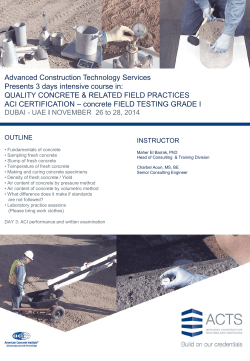
Estimation of Prestress Loss by Steam Curing Process
Proceedings of the International Conference on Civil, Structural and Transportation Engineering Ottawa, Ontario, Canada, May 4 – 5, 2015 Paper No. 299 Estimation of Prestress Loss by Steam Curing Process Chadon Lee, Minhyeok Ko Chung-Ang University, School of Architecture and Building Science 84 Heukseok-Ro, Dongjak-Gu, Seoul, Korea cdlee@cau.ac.kr; kmh6935@naver.com Songhee Lee Chung-Ang University, School of Architecture and Building Science 84 Heukseok-Ro, Dongjak-Gu, Seoul, Korea Sh86136@naver.com Extended Abstract A short-term loss of prestress occurs for the pre-tensioned strand during the steam curing process due to restraint against axial thermal expansion of strand, anchored at a fixed bed (Bruce et al, 2001, Barr et al., 2005). Complexity is involved in predicting the amount of thermal prestress loss as it is affected by many factors such as sectional shape of the member, steam during schedule and its temperature distributions, hydration heat related to chemical composition of concrete, material properties, and interactions between strand and concrete at elevated temperature. In addition to the lack of comprehensive theoretical model, sporadic experimental results on the thermal prestress loss have led the amount of thermal prestress loss to remain inconsistent and inconclusive. Accordingly, there exist inconsistent code provisions regarding the amount of thermal prestress loss (CEB-FIP, 1993, Eurocode 2, 2004). A theoretical model is presented in this research to predict the thermal loss of pre-tensioned tendons embedded in prestressed pre-tensioned concrete member. The developed model is composed of heat transfer model and the bond-slip model between the strand and concrete at elevated temperature. Some conditions are assumed that the prestressing bed is fixed to the supporting ground and completely insulated from the heating system. The steam is supplied into the insulation system and it affect temperature changes in concrete, strand and mold only. With the increase of temperature due to both of the penetrated steam heat and the heat of hydration generated in concrete, strand inside concrete continued to extend. The heated strand, however, is prohibited to extend to some degree along the span by the resistances resulting from axial compressive stress exerted by the strand at ambient temperature, located outside the insulation system, and bond stresses between the embedded strand and surrounding concretes, generated by the slip along the strand length in longitudinal direction. A second order nonlinear differential equation was developed in terms of an infinitesimal segment of embedded tendon in heated concrete. Combined with heat transfer model, the model accounts for various factors such as beam geometry, reinforcement, material properties at elevated temperature, steam curing schedule and temperature distributions. Using the developed model, parametric studies were performed. It was found that the amount of prestress loss during the steam curing could be as much as 5.0% of initial prestress and largely depends on the maximum temperature during the steam curing process and sectional shape of the beam geometry. Barr P.J., Stanton J.F. and Eberhard M.O (2005). Effects of temperature variations on precast, prestressed concrete bridge girders. J. Bridge Eng., 10(2), 186-194. Bruce R.N., Russel H.G., Roller J.J. and Hassettt B.M. (2001). Implementation of high performance concrete in Louisiana bridges. Report No.310, LA:Louisiana Transportation Research Center, Baton Rouge 299-1 CEB-FIP Model Code 1990 (1993). Bulletin d’Information 203-205. Comite-Euro-International du Beton (CEB), Lausanne. European Committee for Standardisation (CEN) (2004). Eurocode 2: Design of concrete structures-Part 11: General rules and rules for buildings. EN1992-1-1:2004:E 299-2
© Copyright 2025









